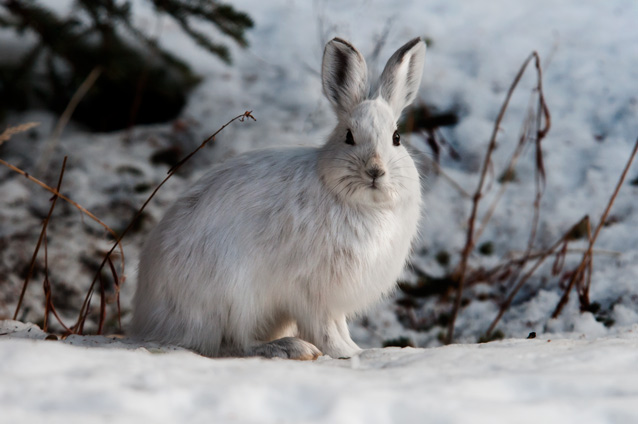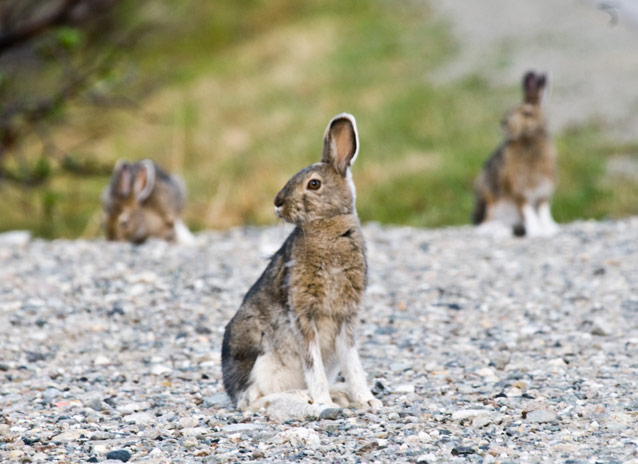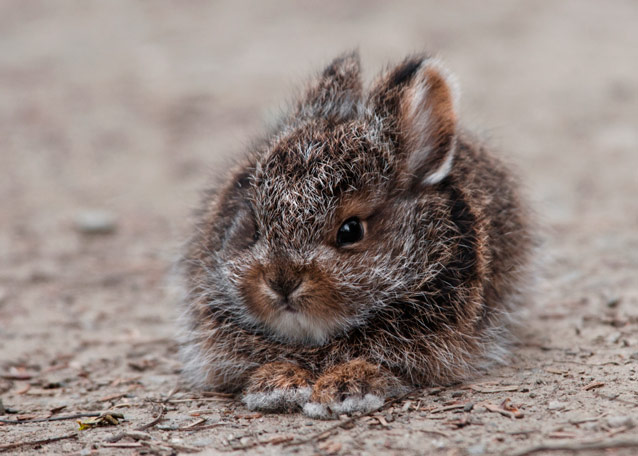Snowshoe hares live throughout the boreal, or northern, forest. As an important prey species for a wide variety of predators, the population size and reproductive success of many predators cycles with the abundance of hare.

NPS Photo
Snowshoe hares live in the boreal forests of North America and are active year-round. They gain their curious name from their very large hind feet that are lined with stiff hairs that form a snowshoe, supporting their weight on the surface of the snow.
They blend in well with their surroundings because of their seasonal variation in fur color, from brown in summer to almost pure white in winter. The gradual shedding of the coat and replacement of the guard hairs occurs two times per year and is triggered by changes in day-length. In national parks across interior Alaska, they inhabit spruce forests as well as shrubby habitats in riparian areas. In many areas of the boreal forest, snowshoe hares are the dominant herbivore.
Snowshoe hare populations cycle in 8 to 11 year periods, and densities may fluctuate 5 to 25-fold during a cycle. The causes of the cyclic fluctuations of snowshoe hares are debated among scientists. Scientists have proposed many hypotheses to explain the changes in population size that lead to these cycles. These hypotheses usually center on food limitation, patterns of predation, and links between food supply and predation. Recent studies in Kluane National Park and Reserve, Yukon, Canada suggest that cyclic fluctuations of snowshoe hares probably result from an interaction between predation and food supplies.

NPS Photo
Snowshoe Hare Ecology
Diet
The diet of snowshoe hares is diverse. In summer they eat herbaceous plants and the new growth of woody vegetation. In winter, they eat twigs, buds, and bark. Snowshoe hares browse heavily on vegetation and often leave behind well-defined browse-lines (often referred to as "hare lines"). Hares will also re-ingest their feces to extract all of the available nutrients from their food.
Reproduction
The first mating of the year occurs in spring (March and April) and a litter of usually two to four young (leverets) is born about 35 days after mating. Hares produce two to three litters of young a year and females remate soon after the birth of a litter. Males and females have multiple mates throughout the year. Young hares move about soon after they are born and young snowshoe hares usually begin to breed a year after their birth. Reproductive rates vary by region and by year.
Survival
Hares are well adapted for escaping their predators. They have keen hearing and upon detecting a predator they often freeze in their tracks. This, in addition to their camouflage coloration, tends to be an effective means of avoiding predators.

NPS Photo
Hares greatly influence the world around them, including the vegetation, predators, and other herbivores and omnivores that live in the same habitats. Hares browse heavily on vegetation. Browsing affects the growth of plants and stimulates plants to produce secondary compounds that make them unpalatable for hares and other omnivores.
The relationship between snowshoe hares and their year-round predators including lynx, great-horned owls, and northern goshawks is well documented. These and other predators such as golden eagles depend on snowshoe hares as a food source early in the nesting season. Across the boreal forest, the population size and reproductive success of many predators cycles with the abundance of hare.
Last updated: October 28, 2021
